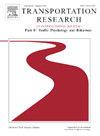Anticipatory vibrotactile cues reduce motion sickness in car passengers during stop-and-go driving
IF 3.5
2区 工程技术
Q1 PSYCHOLOGY, APPLIED
Transportation Research Part F-Traffic Psychology and Behaviour
Pub Date : 2024-10-18
DOI:10.1016/j.trf.2024.10.011
引用次数: 0
Abstract
Approximately 2/3 of all people have suffered from carsickness at some point in their lives with symptoms including disorientation, headache, apathy, nausea, or even vomiting. The development and introduction of automated driving functions are expected to further increase the frequency of occurrence and the symptom severity of carsickness, in particular when the passenger’s eyes are no longer on the road during non-driving related activities. Although the symptoms associated with carsickness are unpleasant and may limit the acceptance of automated driving functions, effective and applicable countermeasures are still scarce. In the genesis of carsickness, the ability to anticipate upcoming vehicle movements may be a relevant factor. Previous studies examining the effects of anticipatory cues on carsickness, mostly using laboratory setups, revealed mixed results, some suggest a positive effect of anticipatory cues on carsickness, others do not. In the present study, we investigated the effect of anticipatory, vibrotactile stimuli on the development of motion sickness in a partially automated drive on a test track. In a repeated measures design, 37 participants experienced two 17-minute stop-and-go rides. During the ride, they watched a movie and were asked about their current motion sickness level every minute using the Fast Motion Sickness Scale (FMS). In the intervention condition, participants also received vibrotactile cues about upcoming braking and acceleration via a vibrotactile belt one second in advance of the event. The results indicate an alleviating effect of vibrotactile cues on motion sickness.
预期振动触觉线索可减少汽车乘客在走走停停的驾驶过程中产生的晕车症状
大约有三分之二的人在一生中的某个阶段都曾患过晕车症,症状包括迷失方向、头痛、淡漠、恶心甚至呕吐。自动驾驶功能的开发和引入预计将进一步增加晕车的发生频率和症状严重程度,尤其是当乘客在非驾驶相关活动中眼睛不再注视路面时。虽然晕车的相关症状令人不快,可能会限制人们对自动驾驶功能的接受程度,但有效且适用的应对措施仍然匮乏。在晕车的成因中,预测即将到来的车辆运动的能力可能是一个相关因素。以往的研究大多使用实验室设置来研究预期线索对晕车的影响,结果不一,有些研究表明预期线索对晕车有积极影响,有些则没有。在本研究中,我们调查了在测试跑道上进行部分自动驾驶时,预期性振动触觉刺激对晕车发生的影响。在重复测量设计中,37 名参与者经历了两次 17 分钟的走走停停的驾驶。在乘坐过程中,他们观看了一部电影,并使用快速晕动病量表(FMS)每分钟询问他们当前的晕动病程度。在干预条件下,参与者还能提前一秒通过振动带接收到即将到来的制动和加速的振动触觉提示。结果表明,振动触觉提示对晕动症有缓解作用。
本文章由计算机程序翻译,如有差异,请以英文原文为准。
求助全文
约1分钟内获得全文
求助全文
来源期刊
CiteScore
7.60
自引率
14.60%
发文量
239
审稿时长
71 days
期刊介绍:
Transportation Research Part F: Traffic Psychology and Behaviour focuses on the behavioural and psychological aspects of traffic and transport. The aim of the journal is to enhance theory development, improve the quality of empirical studies and to stimulate the application of research findings in practice. TRF provides a focus and a means of communication for the considerable amount of research activities that are now being carried out in this field. The journal provides a forum for transportation researchers, psychologists, ergonomists, engineers and policy-makers with an interest in traffic and transport psychology.

 求助内容:
求助内容: 应助结果提醒方式:
应助结果提醒方式:


